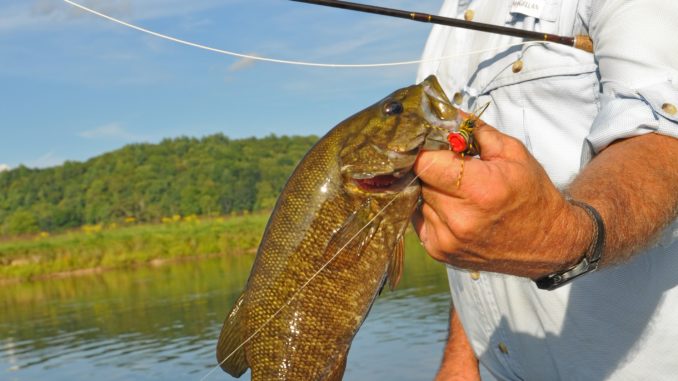
The New River is a summer destination for anglers who want to beat the head and catch a smallmouth bass in beautiful surroundings.
Last July, the New River appeared similar but also different than 42 years earlier, the last time I floated the stream in a canoe. It was 1974, and local residents and conservation organizations were fighting a plan to dam the pristine river that crosses the northwestern corner of North Carolina. Back then, no guides carried fishing parties on the river, and no businesses catering to anglers and paddlers had sprouted along its banks.
Today, more than a dozen guides and guide services offer a variety of canoe, raft and kayak adventures, including fishing and sight-seeing trips. Nowadays, thousands of anglers and paddlers from many states enjoy this scenic, unique mountain stream.
Two of the most experienced guides are Marty Shaffner from the Wilkes County town of Austin and Jeff Payne of North Wilkesboro, a retired UPS employee who has partnered with Shaffner to run the Tri-State Angler Guide Service for nine years.
“I fish for smallmouths on several North Carolina streams, but I’d say the New River, especially the South Fork, is the best, especially in summer,” said Shaffner, 50. “The New River has been rated as one of the top three smallmouth streams in America.”
Smallmouth bass have always inhabited the river, which is too cool and shallow to support largemouths. Trout are stocked in two areas, on the South Fork near the community of Todd and on the North Fork between NC 88 and NC 194.
The New River begins at the confluence of its two main tributaries. The South Fork’s headwaters are in Watauga County’s mountains. The North Fork is born in the high country of Ashe County near the Tennessee line where small streams drain the slopes of Snake Mountain. The two streams meander eastward, eventually to joining forces near Twin Rivers, about 3 miles south of the Virginia border in rural Alleghany County. It’s below that confluence that the New River boasts unbelievable fishing for smallmouth bass, aka bronzebacks.
“The nice thing about fishing the New River in summer is you can drop anchor, step into the river and cast to good-looking water,” Shaffner said. “Good places to cast are toward banks, as close as you can get. It’s a good tactic to cast upcurrent and let a fly float beneath overhanging limbs into shade.”
Stopping, getting out and fishing are easier from a canoe or kayak than a floating raft, but it can be done. Shaffner, who owns two inflatables, often stops to let anglers cast to prime waters.
“I know where a few big smallmouths, from 4 to 6 pounds, hide, so we usually stop and give ’em a try,” he said.
During March and April he conducts mostly float trips, and clients use spinning tackle and lures. When summer arrives, things change
“From early June through August, we have the best topwater action,” he said. “Fly-rod anglers cast popping bugs and streamers.”
During summer, lures that mimic land-based insects such as grasshoppers, beetles, crickets and ants can be fantastic because bugs regularly fall into the river and are swept by the current to places where smallmouth wait for them. Payne calls it a “buffet line.”
“If I’m using a fly rod, popping bugs are some of my favorite smallmouth lures,” Shaffner said. “One of the best, in my estimation, is a Dixie Devil. It’s got most of what you want in a summer popper — a large concave face and rubber legs like a dragonfly.”
The most-effective way to fish a popping bug is cast and let the fly float downstream while trying to keep contact with the lure. Shaffner advises never to retrieve popping bugs by fast line-stripping.
“It sounds like the wrong thing for a popping bug, but you don’t want to pop it,” Shaffer said. “A lot of my clients are bass fishermen, and they’ve learned to get reaction strikes by making lures move fast. But they need to remember where they are — on a river, not a lake — and current moves floating insects. That’s what smallmouths are used to seeing. They’re used to seeing things that drift along in the current. That’s why you want to dead-drift flies and other lures.”
Another popping bug that works well when drifted near shorelines is a Sneaky Pete. It resembles a Dixie Devil but is darker in color, with four rubber legs.
“But you have to be ready and watch carefully, because smallmouths will suck them under,” Shaffner said. “You need to keep as much slack out of your line as possible so you can get a quick hookset when a fish takes it.”
A 7- or 8-weight, medium fast-action fly rod that’s 6-foot-11 to 9 feet is fine for smallmouths. Reel backing is usually monofilament that takes up space because it’s cheaper than tapered line, which comes next. Floating line should include an 8- or 9-foot tapered leader that drops to an 8- or 10-pound tippet.
When using conventional rods and reels, Shaffner, who prefers 6½-foot G-Loomis rods mated to Daiwa 2500 spinning reels, uses a selection of lures. He uses hard-plastic jerkbaits, especially 3- to 4-inch Rapalas, but also soft-plastic Flukes, paddletails and tube jigs — the latter being especially effective when cast against cliff walls and allowed to sink. A 1/16 – to 1/8-ounce jighead works well.
Jerkbaits take a shallow path when retrieved, usually tracking only 1 to 2 feet deep, perfect for a shallow stream New River that has plenty of deep holes, especially beneath overhanging cliffs or behind ledges or large boulders.
“You can crank a jerkbait and catch fish when smallmouths are chasing (minnows),” Shaffner said, “but they need to be chasing baits.
“If you stop at a pool, say, 4 to 6 feet deep, you can crank down a jerkbait and let it suspend over rocks. Smallmouths like to get behind rocks and out of the current. The current keeps this lure wiggling, and it’ll look like a resting baitfish. Smallmouths that are hiding below, waiting to ambush a critter, will zoom up and smack a suspended jerkbait.”
But for an all-around hard-plastic lure that works the entire day and all over the river during summer, Shaffner said it’s tough to beat a Tiny Torpedo, a topwater propellor bait that resembles a fat 17/8-inch cigar.
“You want to use natural lure colors (green, brown, green pumpkin, watermelon seed, junebug, black, cinnamon, white) in the spring and summer,” said Payne. “New River smallmouths don’t go for colors that aren’t natural.”
“If the water’s clear, green-pumpkin is good,” Payne said. “If it’s muddy, I’ll use black or Junebug. If the water has a light stain, white and cinnamon are best.”
Shaffner said a 4-inch Senko in a cinnamon hue resembles a drowned earthworm, swept by current along the bottom after a rain. It’s a devastating lure. On our trip last July, the three of use caught around two-dozen smallmouth ranging from 2 to 4 pounds on a 4-mile float.
In July and August, Shaffner drops to 1/16-ounce weights for plastic lizards and tubes because of changing current speeds, as less rain lowers the river level.
One of his favorite choices is a 4-inch green or brown Senko with a 2-foot fluorocarbon leader. Shaffner prefers 4/0 plain hooks, while Payne likes red hooks size 4/0 or larger. Their fishing trips are totally for catch-and-release.
“I don’t want to kill these fish, and sometimes, they’ll inhale a small hook,” Shaffner said. “We also rig worm hooks weedless to cut down on hang-ups and deep hookups.”
Sight fishing for river smallmouths from a moving raft isn’t easy, but it pays off when anglers see signs of activity.
“I’ve caught fish by casting to smallmouths busting river shiners or jumping to eat damsel flies,” he said. “If there’s a damsel-fly hatch, smallies get active.”
Rocks from top to bottom affect New River current flows. To prevent hang-ups, Shaffner recommends anglers cast bottom-bumpers at an angle in front of their watercraft.
“You don’t want to cast across a lot of seams, because hooks may snag when you wind (a lure) back and it goes across a seam’s edge,” he said.
DESTINATION INFORMATION
HOW TO GET THERE — From points east, take I-40 to Winston-Salem and US 421 west. To access the river around Sparta, take US 21 north. To access the river in West Jefferson, take NC 16 to NC 88 toward Wagner and Laurel Springs and New River State Park.
WHEN TO GO — May through September.
BEST TECHNIQUES — Fly-fishing or light spinning tackle are equally productive in the New River. Surface popping bugs floated in the current will draw strikes from smallmouth bass, as will soft-plastic Flukes, paddletails, tube jigs, worms, lizards and Senkos fished on light jigheads or small jerkbaits.
FISHING INFO/GUIDES — Marty Shaffner, Tri-State Angler Guide Service, 336-957-4630; Jeff Payne, Tri-State Angler Guide Service, 336-902-5497, www.tristateangler.com. See also Guides and Charters in Classifieds.
ACCOMMODATIONS — Alleghany Inn, Sparta, 336-372-2501, www.alleghanyinn.com; Days Inn, West Jefferson, 800-238-0767. Primitive camping, including canoe camping, is available at New River State Park, 877-722-6762.
MAPS — New River State Park map, www.ncparks.gov/sites/default/files/ncparks/maps-and-brochures/new-river-park-map.pdf.

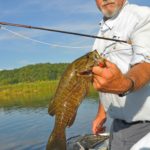
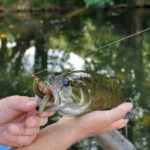
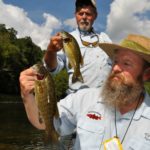

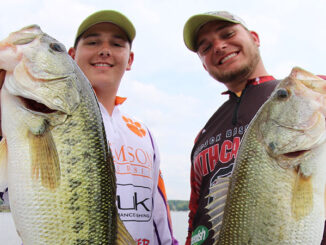


Be the first to comment